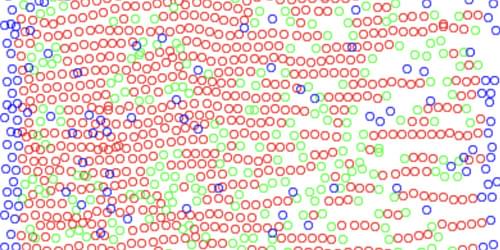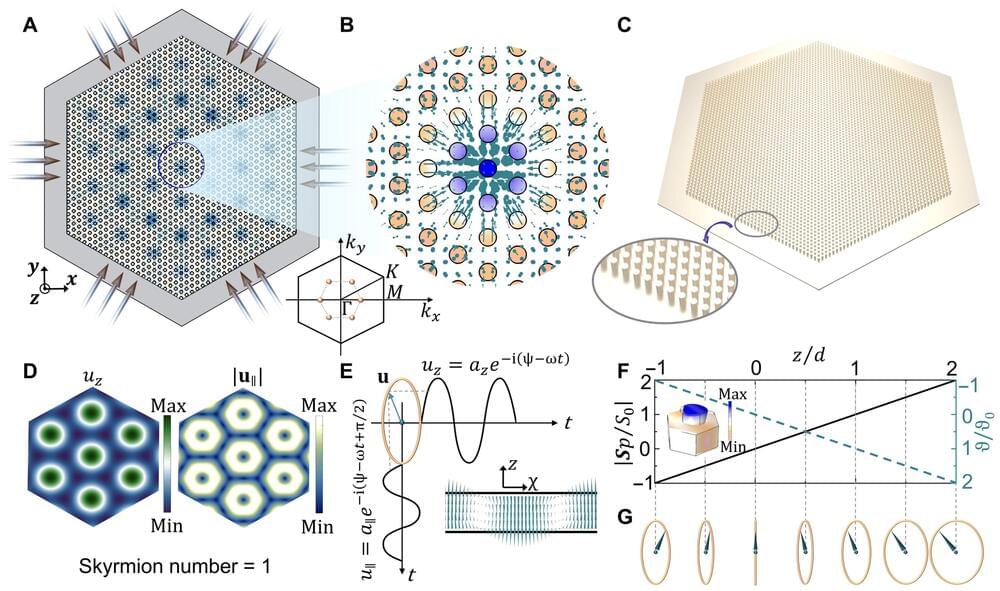Simulations and an experiment aboard the International Space Station show that changes in the system’s repulsive forces are behind the alignment of particles embedded in an electrified plasma.



“If we could see the air we fly in, we wouldn’t,” is a common saying among glider pilots. The invisible turbulent pockets that accompany soaring thermals present hazards to small aircraft, but today’s observational tools struggle to measure such wind features at high spatial resolutions over large distances. Now Yunpeng Zhang of the University of Science and Technology of China and his colleagues demonstrate how adapting a remote-sensing technology called pulsed coherent Doppler lidar (PCDL) enables long-range wind detection with submeter resolution [1].
PCDL senses wind speeds by detecting the frequency shift when a laser pulse scatters off dust particles in the air. By measuring the time taken for this scattered light to return to the detector, the technique allows wide-region profiling of wind speeds. This large-scale sampling comes at the cost of measurement precision, however. Measuring the laser’s travel time requires short-duration pulses, but short pulses transmit little total energy for a given laser power, and this energy is necessarily dispersed over a wide frequency range.
To avoid this trade-off, Zhang and his colleagues imprinted a phase-modulation pattern within each transmitted pulse using an electro-optic modulator. This pattern broke the link between pulse duration and spatial resolution, allowing a more flexible pulse duration. As a result, their setup achieved a spatial resolution of 0.9 m at a distance of 700 m (compared to a 3-m resolution at 300 m for a conventional instrument) and was able to detect the wind from an electric fan on a rooftop 329 m away.

Carbon nanotubes (CNTs) are cylindrical tube-like structures made of carbon atoms that display highly desirable physical properties like high strength, low weight, and excellent thermal and electrical conductivities. This makes them ideal materials for various applications, including reinforcement materials, energy storage and conversion devices, and electronics.
Despite such immense potential, however, there have been challenges in commercializing CNTs, such as their incorporation on plastic substrates for fabricating flexible CNT-based devices. Traditional fabrication methods require carefully controlled environments such as high temperatures and a clean room. Further, they require repeat transfers to produce CNTs with different resistance values.
More direct methods such as laser-induced forward transfer (LIFT) and thermal fusion (TF) have been developed as alternatives. In the LIFT method, a laser is used to directly transfer CNTs onto substrates, while in TF, CNTs are mixed with polymers that are then selectively removed by a laser to form CNT wires with varying resistance values.

Imagine a sheet of material just one layer of atoms thick—less than a millionth of a millimeter. While this may sound fantastical, such a material exists: it is called graphene and it is made from carbon atoms in a honeycomb arrangement. First synthesized in 2004 and then soon hailed as a substance with wondrous characteristics, scientists are still working on understanding it.
Postdoc Areg Ghazaryan and Professor Maksym Serbyn at the Institute of Science and Technology Austria (ISTA) together with colleagues Dr. Tobias Holder and Professor Erez Berg from the Weizmann Institute of Science in Israel have been studying graphene for years and have now published their newest findings on its superconducting properties in a research paper in the journal Physical Review B.
“Multilayered graphene has many promising qualities ranging from widely tunable band structure and special optical properties to new forms of superconductivity—meaning being able to conduct electrical current without resistance,” Ghazaryan explains.
While tunneling reactions are remarkably hard to predict, a group of researchers were able to experimentally observe such an effect, marking a breakthrough in the field of quantum chemistry.
Tunnel Effect
Predicting tunnel effects is very difficult to pull off. The mechanically exact quantum description of chemical reactions that cover over three particles is quite hard. If it covers over four particles, it is almost impossible to pull off. In order to stimulate the reactions, scientists use classical physics but have to push aside the quantum effects. However, EurekAlert reports that there is a limit to classically describing these chemical reactions. What, then, is the limit?

The novel method could form a crucial part of NASA’s plans to establish a permanent human presence on the moon.
You may not know that lunar dust poses a real problem to NASA as it aims to establish a permanent crew presence on the moon with its upcoming Artemis missions.
Now, though, a new liquid nitrogen spray developed by Washington State University researchers was able to remove virtually all of the simulated moon dust from a space suit during tests, a press statement reveals.
NASA
Moondust is largely made of small particles that can damage spacesuits, machinery, and equipment. In future habitats, it may even pose a health risk by damaging astronauts’ lungs.

The supernova is so old that it is believed to have been described in a passage of Shakespeare’s “Hamlet.”
A group of scientists has shed new light on a star that exploded in a supernova more than 450 years ago, blasting particles out into space at close to the speed of light.
Now, astronomers have used NASA’s Imaging X-ray Polarimetry to study the incredibly long-lasting aftereffects of the supernova called Tycho.
NASA/ASI/MSFC/INAF/R. Ferrazzoli, et al.
The Tycho supernova blast released as much energy as the Sun would emit over ten billion years, NASA pointed out in a statement. The blast was visible to many humans on Earth way back in 1572.

Tunneling reactions in chemistry are difficult to predict. The quantum mechanically exact description of chemical reactions with more than three particles is difficult, with more than four particles it is almost impossible. Theorists simulate these reactions with classical physics and must neglect quantum effects. But where is the limit of this classical description of chemical reactions, which can only provide approximations?
Roland Wester from the Department of Ion Physics and Applied Physics at the University of Innsbruck has long wanted to explore this frontier. “It requires an experiment that allows very precise measurements and can still be described quantum-mechanically,” says the experimental physicist. “The idea came to me 15 years ago in a conversation with a colleague at a conference in the U.S.,” Wester recalls. He wanted to trace the quantum mechanical tunnel effect in a very simple reaction.
Since the tunnel effect makes the reaction very unlikely and thus slow, its experimental observation was extraordinarily difficult. After several attempts, however, Wester’s team has now succeeded in doing just that for the first time, as they report in the current issue of the journal Nature.

Skyrmions are extremely small with diameters in the nanoscale, and they behave as particles suited for information storage and logic technologies. In 1961, Tony Skyrme formulated a manifestation of the first topological defect to model a particle and coined it as skyrmions. Such particles with topologically stable configurations can launch a promising route toward establishing high-density magnetic and phononic (a discrete unit of quantum vibrational mechanical energy) information processing routes.
In a new report published in Science Advances, Liyun Cao and a team of researchers at the University of Lorraine CNRS, France, experimentally developed phononic skyrmions as new topological structures by using the three-dimensional (3D) hybrid spin of elastic waves. The researchers observed the frequency-independent spin configurations and their progression toward the formation of ultra-broadband phononic skyrmions that could be produced on any solid structure.